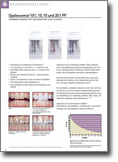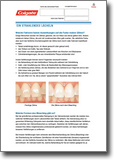Whitening
Teeth whitening with splint |
Causes of tooth discoloration
Tooth discoloration can occur from the outside by coloring food and beverages, such as alcoholic beverages, tea, tobacco smoke, coffee, red wine, etc. penetrate into the tooth or from the inside through the effects of medication, as a result of accidents, tooth decay, death of the pulp, malnutrition, etc.
It has been known for several years that damage to tooth enamel (and gums) can occur if teeth are brushed immediately after ingestion of acidic foods (e.g. juice or nectar, fruits such as bananas, pineapples, oranges, etc.). Therefore, it is recommended to rinse the mouth with clean water before each tooth cleaning to prevent these acids from being massaged into the tooth and gums.
Methods for teeth whitening
For teeth whitening, preparations containing hydrogen peroxide (H2O2) are usually used. They can penetrate the tooth and split off oxygen radicals there. These are able to chemically change dyes in the tooth in such a way that they no longer appear in color. Teeth whitening agents should have a neutral pH value so that they do not roughen the teeth and thus do not promote re-discoloration. Different methods are used:
1) Whitening with custom-made dental splints ("home bleaching")
In this case, a custom-fit plastic splint is deep-drawn and cut out for the patient – after impression of the teeth and model production – by the dental practice or its laboratory or by a dental osmetician, which covers the teeth. For teeth whitening, this splint is filled with peroxide-containing whitening gel. The Home Bleaching Gel usually has a concentration of 10 to 20 percent peroxide. Depending on the concentration and individual initial situation, the patient wears these splints for between one and eight hours. In the case of so-called "age discolorations", five to seven treatments are often sufficient, in the case of more persistent discolorations, e.g. by tetracyclines, 15 or more treatments are often necessary.
2) Lightening by direct application ("power bleaching" or "in-office bleaching")
Teeth whitening with demarcation gel |
Here, higher concentrated preparations are used. Therefore, this treatment is carried out in the patient's chair of the dentist or dental cosmetician. For preparation, the gums are protected (covered) with a rubbery coating, the "rubber dam", or a flowable material (usually based on composite), the "gingiva protector". The whitening agent is applied by the practitioner directly to the teeth to be whitened and acts there. Sometimes the effect is intensified by light irradiation with bleaching lamps. However, this is only possible with bleaching gels, which are chemically activated by the action of short-wave light (cyan/blue or UV light). After 15–45 minutes, the gel is removed. If the whitening is not sufficient, the procedure can be repeated. As a rule, one or two treatments are necessary for a first teeth whitening in order to achieve a lasting result (one year or longer).
3) Whitening by inserts in the tooth ("walking bleach technique")
If a single, devital (dead, "dead") tooth is to be whitened, this can also be done with an insert in the tooth. The crown of the tooth is opened (it has already been drilled open by the previous root canal treatment) and a suitable agent is introduced into the cavity that used to fill the pulp (pulpa dentis). The tooth is provisionally closed again and the whitening agent is left in the tooth for one or more days. After removal of the whitening agent, the crown is permanently sealed again. It takes a few days for the peroxide from the inside of the tooth to work its way through the enamel. The brightening is therefore time-delayed. If the tooth color achieved does not correspond to the desired result, the method can be repeated. Therefore, many dentists also refrain from prematurely closing the crown again until the desired color is reached.
Method 1 is especially indicated if the entire dental arch is to be whitened. Method 2 is usually chosen when it comes to whitening individual, especially vital (living) teeth, or when it should go very quickly. Method 3 is suitable for individual devital (dead) teeth.
further information about bleaching
 |
 |
 |
|||
